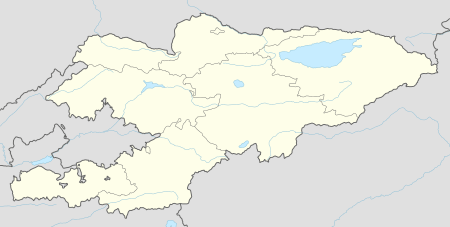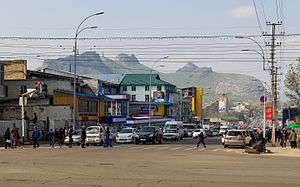Osh
| Osh Ош | |||
|---|---|---|---|
|
Osh, with Sulayman Mountain in the background | |||
| |||
 Osh Location in Kyrgyzstan | |||
| Coordinates: 40°31′48″N 72°48′0″E / 40.53000°N 72.80000°E | |||
| Country |
| ||
| Region | Osh Region | ||
| Government | |||
| • Mayor | Aitmamat Kadyrbaev | ||
| Elevation | 963 m (3,159 ft) | ||
| Population (2012) | |||
| • Total | 255,900 | ||
| Time zone | KGT (UTC+6) | ||
| Website | http://oshcity.kg | ||
Osh (Kyrgyz: Ош) is the second largest city in Kyrgyzstan, located in the Fergana Valley in the south of the country and often referred to as the "capital of the south". It is the oldest city in the country (estimated to be more than 3000 years old), and has served as the administrative center of Osh Region since 1939. The city has an ethnically mixed population of about 255,800 in 2012, comprising Kyrgyz, Uzbeks, Russians, Tajiks, and other smaller ethnic groups.
Overview
Osh is a lively place with the largest and most crowded outdoor market in Central Asia which was a major market along the Silk Road and is now named the Great Silk Road Bazar in reference to its historical importance. The city's industrial base, established during the Soviet period, largely collapsed after the break-up of the Soviet Union and has recently only started to revive. The proximity of the Uzbekistan border, which cuts through historically linked territories and settlements, deprives Osh of much of its former hinterland and presents a serious obstacle to trade and economic development. Daily flights from Osh Airport link Osh - and hence the southern part of Kyrgyzstan - to Bishkek and the north. Like most of Kyrgyzstan, Osh has no railway connections, although the recent upgrading of the long and arduous road through the mountains to Bishkek has greatly improved communications.
The city has several monuments, including one to the southern Kyrgyz "queen" Kurmanjan Datka and one of the few remaining statues of Lenin. A Russian Orthodox church, reopened after the demise of the Soviet Union, the largest mosque in the country (situated beside the bazaar) and the 16th-century Rabat Abdul Khan Mosque can be found here. The only World Heritage Site in Kyrgyzstan, the Sulayman Mountain, offers a splendid view of Osh and its environs. This mountain is thought by some researchers and historians to be the famous landmark of antiquity known as the “Stone Tower”, which Claudius Ptolemy wrote about in his famous work Geography (Ptolemy). It marked the midpoint on the ancient Silk Road, the overland trade route taken by caravans between Europe and Asia.[1] The National Historical and Archaeological Museum Complex Sulayman is carved in the mountain, containing a collection of archaeological, geological and historical finds and information about local flora and fauna.
Its first western-style supermarket Narodnyj opened in March 2007.[2]
Administration
Osh city (Ош шаар) Osh shaar covers about 50 square kilometres (19 square miles) and like the capital city, is administered separately and not part of any province, including Osh Province.
Population
Osh is the second largest city in Kyrgyzstan after the capital city of Bishkek. According to census of 2009 the city population amounted to 258,000 (48% Kyrgyz, 44% Uzbeks, 3% Russians, 2% Turks and 1% Tatars).[3] The population of the city with its suburbs is estimated at about 500,000 inhabitants (for 2012).
History
Early history
_drive_the_enemy_out_with_sticks_and_clubs_and_hold_the_town_for_Babur.jpg)
The city is among the oldest settlements in Central Asia. Osh was known as early as the 8th century as a center for silk production along the Silk Road. The famous trading route crossed Alay Mountains to reach Kashgar to the east. In modern times, Osh has become also the starting point of the Pamir Highway crossing the Pamir Mountains to end in Khorog, Tajikistan.
Babur, founder of the Mughal Empire and descendant of Tamerlane, was born in nearby Andijan, in the Fergana Valley, pondered his future on Sulayman Mountain and even constructed a mosque atop of the mountain. Babur somehow concludes that the confines of the Fergana would cramp his aspirations as a descendant of famous conquering warrior princes. He wrote of the city:
"There are many sayings about the excellence of Osh. On the southeastern side of the Osh fortress is a well-proportioned mountain called Bara-Koh, where, on its summit, Sultan Mahmud Khan built a pavilion. Farther down, on a spur of the same mountain, I had a porticoed pavilion built in 902 (1496-7)" [4]
Imperial Russian and Soviet rule
The city was occupied and annexed by the Russian Empire in 1876 when Russia overwhelmed the Central Asian khanates during the so-called "Great Game", the contest between Britain and Russia for dominance in Central Asia. This conquest was achieved and the inclusion to the Russian empire made by mid 1880's, with main credit to General von Kaufman and General Mikhail Skobelev, nicknamed the "White General" from his victories and achievements in the Russo-Turkish war of 1877-78 (he wore always a white uniform and rode a white stallion in battle).
The Kara-Kyrgyz Autonomous Oblast was created within the Russian SFSR of the newly formed Soviet Union in 1924, with Osh as a part.
In the 1960s Osh and other towns in the south of the Kyrgyz SSR began to be industrialized. The population of Osh and other towns in the Fergana Valley that falls within Kyrgyzstan has traditionally consisted of a significant number of ethnic Uzbeks.[5] When Osh started to industrialize the ethnic "Kyrgyz were encouraged to move from the Kyrgyz populated countryside to the cities to work in industrial jobs and public administration."[5] This contributed to the rise of social tension between the two groups.
1990 riots
In 1990, shortly before the end of Soviet power in Central Asia, Osh and its environs experienced bloody ethnic clashes between Kyrgyz and Uzbeks. There were about 1,200 casualties, including over 300 dead and 462 seriously injured.[5] The riots broke out over the division of land resources in and around the city.[6]
2010 ethnic violence
In 2010, after riots in Bishkek and other major Kyrgyz cities, President Kurmanbek Bakiyev took refuge in the city to hide from protesters denouncing his government and its response to the nation's struggling economy. On May 13, 2010, Bakiyev supporters took over government buildings in Osh, and also seized the airport, preventing interim government officials from landing.[7] The protesters demanded Bakiev's return, and forced the regional governor to flee. The former Osh regional governor Mamasadyk Bakirov was reinstated.
On June 10, 2010, riots erupted in Osh, killing at least 400 and injuring thousands of others.[8] "An explosion of violence, destruction and looting in southern Kyrgyzstan on 11–14 June 2010 killed many hundreds of people, Kyrgyz and Uzbeks got killed and destroyed over 2000 buildings, mostly homes, and deepened the gulf between the country’s ethnic Kyrgyz and Uzbeks."[9]
Local media reported that gangs of young men armed with sticks and stones smashed shop windows and set cars aflame in the city center. Several buildings and homes across the city were also set on fire. The city's police force proved incapable of restoring order resulting in a state of emergency being declared and the army being mobilised.[10] The Kyrgyz intelligence agency claimed that the 2010 violence was initiated by the just-deposed president, Kurmanbek Bakiyev, who is said to have made a deal with foreign narco-jihadist gangs to take over southern Kyrgyzstan and initiate a shariah state in exchange for the Bakiyev family's being returned to controlling Bishkek.[11] However, to the day no serious proof has been presented to the public and media. According to various sources, up to 100,000 ethnic Kyrgyz and Uzbek refugees fled to Uzbekistan. Many refugee camps have been organized in the Andijan, Fergana and Namangan regions of Uzbekistan for citizens of Kyrgyzstan who cross the border seeking safety.
Geography
Climate
Under the Köppen climate classification, Osh features a continental climate (Dsa), with hot, dry summers and cold winters. Osh receives on average roughly 400 millimeters of precipitation annually, the bulk of which typically falls on the city outside the summer months. Summers are hot in Osh, with average high temperatures routinely exceeding 30°C. Winters are cold with average temperatures below freezing during a good portion of the season. Spring and autumn are transitional seasons, with temperatures rising during the course of the spring season and falling during the course of the autumn.
| Climate data for Osh | |||||||||||||
|---|---|---|---|---|---|---|---|---|---|---|---|---|---|
| Month | Jan | Feb | Mar | Apr | May | Jun | Jul | Aug | Sep | Oct | Nov | Dec | Year |
| Average high °C (°F) | 2 (36) |
4 (39) |
12 (54) |
18 (64) |
25 (77) |
31 (88) |
33 (91) |
32 (90) |
27 (81) |
19 (66) |
13 (55) |
5 (41) |
18.4 (65.2) |
| Average low °C (°F) | −6 (21) |
−5 (23) |
2 (36) |
6 (43) |
11 (52) |
16 (61) |
18 (64) |
17 (63) |
11 (52) |
6 (43) |
−2 (28) |
−4 (25) |
5.8 (42.6) |
| Average precipitation mm (inches) | 34 (1.34) |
42 (1.65) |
61 (2.4) |
67 (2.64) |
47 (1.85) |
23 (0.91) |
9 (0.35) |
7 (0.28) |
6 (0.24) |
37 (1.46) |
36 (1.42) |
47 (1.85) |
416 (16.39) |
| Source: Yandex weather[12] | |||||||||||||
Cityscape

Twin towns - sister cities
Osh is twinned with:
See also
- Jamala
- Bakyt Beshimov
- Roza Otunbayeva
- Timur Belyasov
References
- ↑ Dean, Riaz (2015). "The Location of Ptolemy's Stone Tower: The Case for Sulaiman-Too in Osh." (PDF). The Silk Road.
- ↑ In Osh opened a supermarket "Narodnyj".
- ↑ National Statistical Committee of Kyrgyz Republic. National Census 2009. Vol. III(tables). Regions of Kyrgyzstan. Osh City.
- ↑ The Babur-nama Ed. & trans. Wheeler M. Thackston (New York) 2002 pp4-5
- 1 2 3 "Report of the Independent International Commission of Inquiry into the Events in Southern Kyrgyzstan in June 2010" (PDF). The Independent International Commission of Inquiry (KIC). Retrieved 22 April 2012.
- ↑ "Osh". Redmond, WA: Microsoft® Student 2009 [DVD]. 2008.
- ↑ "Former Kyrgyz President's Supporters Take Over Government Buildings In South". Radio Free Europe. 13 May 2010. Retrieved 13 May 2010.
- ↑ google.com 12 June 2010
- ↑ "The Pogroms in Kyrgyzstan". International Crisis Group. Retrieved 22 April 2012.
- ↑ "Twelve killed in new wave of unrest in Kyrgyzstan". Associated Press. 10 June 2010. Retrieved 10 June 2010.
- ↑ http://wsinform.com/world/Bishkek-obvinil-Bakieva-v-finansirovanii-popytki-gosperevorota/
- ↑ "Yandex weather" (in Russian). Retrieved September 2, 2012.
- ↑ "Osh and Yozgat city of Turkey became twin cities". Kabar National News Agency. 5 November 2012. Retrieved 28 April 2013.
External links
| Wikimedia Commons has media related to Osh. |
| Wikivoyage has a travel guide for Osh. |
- Info on Osh On Osh State University's Medical Institute's website (English)
- Official website of Medical Institute, Osh State University
- City of Osh Official website (in Russian)
- The Spektator - Society, culture and travel articles on Kyrgyzstan and the Central Asian region
Coordinates: 40°32′N 72°48′E / 40.53°N 72.8°E


